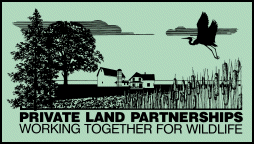 |
|
INTRODUCTION TO
BACKYARD
MANAGEMENT
|
The area around your home, including the
backyard, is the perfect location to enhance wildlife habitat. One reason is that you are
already managing the property--growing and mowing grass, tending to trees and shrubs, and planting flower and vegetable
gardens. You can use these management strategies to enhance wildlife habitat. Another reason the backyard
should be managed for wildlife is that your backyard is probably an edge to another type of habitat such as a
cropland, grassland, woodlot,
brushland, fencerow, hedge, or
other land boundary. With a little management, wildlife that inhabit these edges will most
likely frequent your yard. Further, what better place to enjoy wildlife than in your own
backyard? Also, developing a wildlife management plan for your backyard can enhance the
natural beauty of your home and actually increase its value.
Before you can develop a management plan, you should know what wildlife need to
survive, and thus what will attract them to your yard. Wildlife cannot exist without the
four components that comprise habitat: food, water, cover, and space. When their habitat is fragmented
or destroyed, these components become limited. Remove or fail to provide any one of these
components and wildlife will not survive. These conditions put wildlife at risk, including
vulnerability to predators,
accidents, and starvation. Because some types of wildlife are not very mobile, local
populations may be easily lost when habitat is destroyed. Also, different kinds of
wildlife need different combinations of food, water, cover, and space.
Your property may not be large enough to provide all of the habitat needs for the kinds
of wildlife you wish to attract. However, you can offer one or more components of habitat
and still attract a variety of wildlife to your yard. Usually, a management plan with the
widest range of plantings and artificial structures and features will attract the greatest
assortment and number of birds, mammals, butterflies, moths, amphibians, and reptiles. Working with neighbors on an overall
management plan is a good way to increase both of your properties' appeal to wildlife.
Patience is important because some wildlife species may require several years to find the
habitat and use it.
 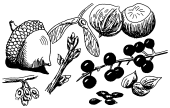
Backyard Habitat Components
Food for wildlife is easy to supply. Besides planting natural foods, you can
supplement with a variety of products, especially for seed-eating birds. Although wildlife
can't survive in your backyard on food alone, you can attract migrant birds and nearby
resident species. The ideal backyard plan supplies as much diversity in food items as possible
through plantings of shrubs, trees, flowers, and grasses. Carefully choosing these plants
can provide food directly in the form of fruits, berries, nuts, seeds, and nectar.
Indirectly, they provide habitat for other sources of food such as insects, spiders,
grubs, and worms. Features such as small ponds and piles of rocks, brush, and leaves
improve both the variety and quantity of available food.
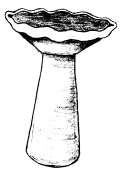 Wildlife need water, for both drinking and bathing. You
can provide water in a birdbath, recirculating waterfall, shallow dish, or dripping hose.
Most desirable is a small, shallow pond with an area large enough to support plants that
grow in water and around the edge. The pond will become the center of activity for a wide
range of wildlife species. Turtles
and frogs will sun there and make use of the pond's cover as a nursery area for their
young. Insects will use the pond for reproduction, greatly enhancing the food chain. Wildlife need water, for both drinking and bathing. You
can provide water in a birdbath, recirculating waterfall, shallow dish, or dripping hose.
Most desirable is a small, shallow pond with an area large enough to support plants that
grow in water and around the edge. The pond will become the center of activity for a wide
range of wildlife species. Turtles
and frogs will sun there and make use of the pond's cover as a nursery area for their
young. Insects will use the pond for reproduction, greatly enhancing the food chain.
Cover helps shield wildlife from harmful weather and protects them from
predators. Different kinds of cover serve the sheltering needs of different wildlife
species. Rock piles or piles of
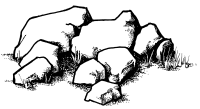 wood, for example, help keep chipmunks safe from hawks and cats.
Brush piles protect rabbits, toads, and salamanders. Dense shrubs shelter chickadees and
cardinals. Painted turtles and leopard frogs hide under submerged logs when threatened.
Cavities in trees offer safe places for squirrels.
The farther an animal must venture from shelter,
the more vulnerable it is to predation, and that is why plants that provide both food and
cover are an important consideration. Placing trees, shrubs, flowers, or grasses in clumps
creates a natural community and
provides diversity. Also, adding specific wildlife houses to your property may attract
bats, wood ducks, and a wide variety of songbirds. wood, for example, help keep chipmunks safe from hawks and cats.
Brush piles protect rabbits, toads, and salamanders. Dense shrubs shelter chickadees and
cardinals. Painted turtles and leopard frogs hide under submerged logs when threatened.
Cavities in trees offer safe places for squirrels.
The farther an animal must venture from shelter,
the more vulnerable it is to predation, and that is why plants that provide both food and
cover are an important consideration. Placing trees, shrubs, flowers, or grasses in clumps
creates a natural community and
provides diversity. Also, adding specific wildlife houses to your property may attract
bats, wood ducks, and a wide variety of songbirds.
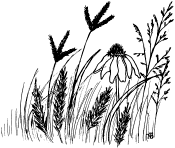 All wildlife need space and some species--in particular
most nesting birds--are highly territorial. Space and territorial needs vary with each
wildlife species. By understanding how much space is necessary for each species, you can
learn what wildlife is attracted to your property. Bluebirds, for instance, are territorial and
need about five acres per pair. In contrast, purple martins are not territorial, and need
only small areas. You can create a larger area for those species that are territorial by
working with neighbors. All wildlife need space and some species--in particular
most nesting birds--are highly territorial. Space and territorial needs vary with each
wildlife species. By understanding how much space is necessary for each species, you can
learn what wildlife is attracted to your property. Bluebirds, for instance, are territorial and
need about five acres per pair. In contrast, purple martins are not territorial, and need
only small areas. You can create a larger area for those species that are territorial by
working with neighbors.
The greater the diversity of habitat, the greater the variety and number of wildlife
species attracted to the habitat. Some of the best backyard habitats are those comprised
of trees bordered by tall shrubs and low shrubs, which are next to wildflowers or native
grasses bordered by a small amount of lawn. Each border provides a different kind of
"edge". What follows is a summary of management ideas for your property. Each
consideration is more fully explained in the chapters in this Backyard
Section.
Trees and Shrubs
Trees and shrubs add color to landscapes,
provide shade in summer, protection from wind in winter, and offer texture to the area
around your home. Planting trees and shrubs in your yard will reduce the area of lawn,
which will reduce mowing and maintenance giving you more time to enjoy your property. In
the long run it will also save you money as you will no longer need fertilizers, pesticides, or irrigation. Plantings
that serve a dual-purpose--providing food for wildlife and aesthetic beauty for your home, for
example--increase in home value, and therefore deserve strong consideration in backyard
planning.
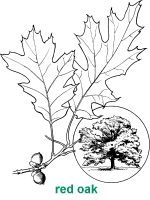 The wildlife habitat components that trees and shrubs create
include cover for nesting and rearing young, secure winter cover, and summer, fall, and
winter foods. For example, dense pines and spruces provide roosting sites and escape cover for
mourning doves, chickadees, and other songbirds. Gray dogwood and American mountain-ash
offer fall fruits to migrating birds. Tall oaks and hickories provide hard mast (nuts) to
squirrels and blue jays in winter and cool shade on hot summer days. The wildlife habitat components that trees and shrubs create
include cover for nesting and rearing young, secure winter cover, and summer, fall, and
winter foods. For example, dense pines and spruces provide roosting sites and escape cover for
mourning doves, chickadees, and other songbirds. Gray dogwood and American mountain-ash
offer fall fruits to migrating birds. Tall oaks and hickories provide hard mast (nuts) to
squirrels and blue jays in winter and cool shade on hot summer days.
When choosing trees and shrubs for your property, considering color, texture, and
height will help you to provide a pleasing landscape. Early blossoming shrubs such as
crabapples, lilacs, and redbud offer spring color. Silky dogwood and red elder give summer
color, and red elder, serviceberry, and red-osier dogwood provide a palette of beauty in
late summer and early fall. Fall-fruiting shrubs and the leaves of maple, birch, aspen,
and other deciduous trees furnish an array of color in fall. Red-osier dogwoods show a
striking red, and conifers give a
pleasing green to a bleak winter landscape.
Pyramidal-shaped American mountain-ash and spruces, round-shaped crabapples and
dogwoods, and flat junipers all add different shapes and sizes to your property. The fine
textures of hemlock, white pine, and serviceberry can be a sharp contrast to
rough-textured plants such as hawthorn and jack pine. Trees and shrubs come in all
heights. Choosing a variety assures nesting and feeding sites for birds with strong
preferences for specific elevations, providing visual screens, and adding to landscape
diversity.
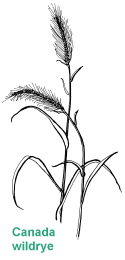 Grasses and Ground Covers Grasses and Ground Covers
Mowed lawns require time and money to maintain, and they provide little habitat for
wildlife. Monocultures of weed-free grass demand water, fertilizers, herbicides, and
frequent mowing, and they are easily stressed by extreme drought or wet conditions. An
estimated 70 percent of pesticide use occurs on the nation's lawns, but those with diverse
wildflowers, groundcovers, and native grasses provide for a healthier, environmentally
friendly lawn, which does not need chemicals. For these reasons, consider reducing the
mowed areas in your yard to as little as possible.
Areas with tall, unmowed, or infrequently mowed grasses can provide outstanding
wildlife habitat such as nesting and brooding areas, insect-foraging sites, and green
foraging areas for deer and rabbits. Brown thrashers, bluebirds, pheasants, and wild
turkeys are among several types of birds that also use such unmowed areas. These can be
places where you let the grass
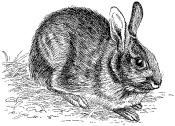 go
wild or where you plant to a specific grass type to create a meadow, prairie, or
wildflower viewing spot. Mixing flowers with grasses is a good choice as they will furnish
a nectar source for bees, butterflies, and hummingbirds. go
wild or where you plant to a specific grass type to create a meadow, prairie, or
wildflower viewing spot. Mixing flowers with grasses is a good choice as they will furnish
a nectar source for bees, butterflies, and hummingbirds.
Ground covers offer an ideal opportunity to reduce the mowed lawn surface and to
develop low-maintenance wildlife habitat. Examples include wild ginger, wintergreen, and
bearberry. They pro-vide nest sites for ground-nesting songbirds, brood-rearing areas for
pheasants and quail, and protective cover for rabbits and chipmunks. Such plantings can
provide more formal settings for wildlife landscaping projects.
Special Feature Gardens
Everyone loves a garden. Specialty gardens serve to enhance viewing pleasure and
attract certain kinds of wildlife. Butterfly, hummingbird, and native prairie gardens are
well suited to this purpose. Besides adding beauty to the landscape, gardens that are
creatively designed and well-tended can increase the value of your property. On larger
properties these special-feature gardens break up the monotony of your lawn and reduce
mowing time. If you do not own property, you can still enjoy a small-scale garden by
arranging planters and potted flowers on the balcony or deck of your apartment, townhouse,
or condominium.
Wildflowers
Michigan has a wide variety of native wildflowers that offer spectacular color and are
well-suited to a number of locations. What better way to create beauty and wildlife
habitat, along with contributing to our state's natural heritage, than by planting native
wildflowers on your property? Once established, wildflowers enhance the attractiveness of
the landscape, help control erosion, furnish food and cover for wildlife, and provide
maximum enjoyment with minimal care. An increasing number of property owners are
converting portions of their large, high-maintenance lawns to plantings of wildflowers.
After the initial cost to establish them, you will save money and time by not having to
fertilize, mow, and rake your lawn. Wildflower stands are also showing up in increasing
numbers on public property, such as highway rights-of-way, corporate industrial parks, and
various recreational areas.
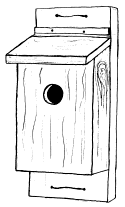 Homes and Feeders for Wildlife Homes and Feeders for Wildlife
Planting trees and shrub thickets give some birds roosting shelters, food sources, and
places to build their nests. Leaving leaf litter, rotting logs, and fallen branches in a
woodland setting provides homes for salamanders and snakes. Standing dead or dying trees (snags) attract woodpeckers, squirrels,
screech owls, and other cavity nesters. Restoring or protecting wetlands helps furnish homes for waterfowl and other wetland birds, turtles, snakes, frogs, toads, and
salamanders. In addition to creating natural homes for wildlife, consider building nest
boxes and feeding stations and placing them in your backyard to enhance viewing pleasure.
In summary, your backyard is the ideal place to create wildlife habitat. Once
established, you will reduce the amount of maintenance, saving time and money. In
addition, you will have attracted many kinds of wildlife to watch and enjoy.
For more information available on the World Wide Web about "Backyard
Management," please see our Resource Links.
Last Revised: May 5, 2000
|

